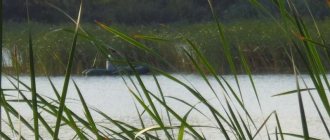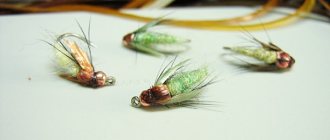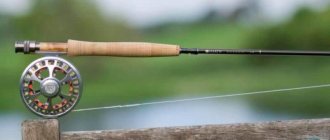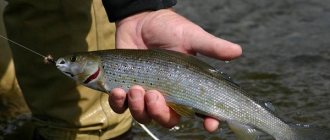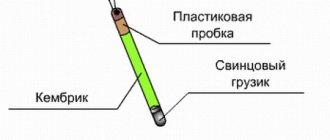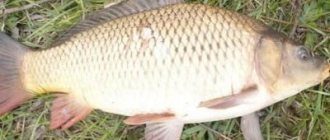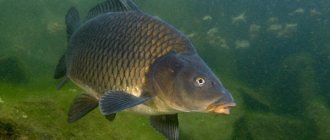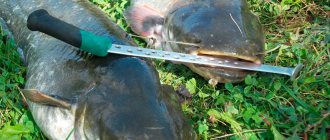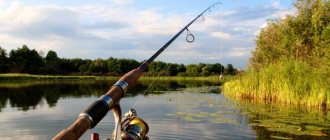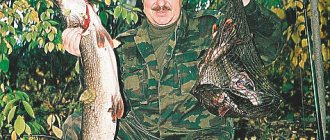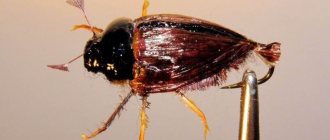Catching grayling is incredibly interesting, regardless of the time of year. This exotic fish for many fishermen, shrouded in an aura of mystery, is quite widespread in our country. Grayling is found everywhere in Russia, with the only exception being the southern part of the country, directly adjacent to the Black Sea coast. Another thing is that some densely populated areas with serious problems with the cleanliness of the ecological situation due to industrial pollution of rivers do not allow this representative of salmon to survive and reproduce in numbers capable of providing fishermen with opportunities for regular and stable fishing.
In this regard, when planning a trip to a reservoir in search of grayling, you need to familiarize yourself with the legislative framework of the region you are visiting and make sure that the extraction of this trophy is permitted by law and does not constitute poaching or the destruction of a small species of ichthyofauna of the area. Having made sure of the legality of his actions, all that remains is to catch the grayling, and the angler will learn about fishing technology, behavioral characteristics of the fish and the best time to catch it from the article presented below.
Description and behavior characteristics
Grayling is one of the brightest and most distinctive representatives of the salmon family, living in freshwater. The fish is a cold-loving species and feels comfortable in reservoirs with water temperatures that do not rise above 17 degrees. In appearance, it is a runaway fish with small, dense scales and a high dorsal fin covered with bright multi-colored dots. It is simply impossible to confuse even a accidentally caught specimen with other fish species.
Fishing for grayling, due to its year-round increased nutritional activity, is possible throughout the year. The fish is omnivorous, although grayling is considered a pronounced predator, which is confirmed by the presence of miniature teeth in the form of bristles. The diet of the population is formed based on the seasonality of the release of a particular food item. At its core, the fish conducts a wait-and-see manner of hunting, choosing a convenient parking spot and picking up food passing by, without particularly moving around the reservoir. Leads a school life, huddling in a group of a dozen similar-sized fish and inhabiting a certain territory.
Spawning in fish is portioned and can consist of three exits, which occur in the spring-summer period of the year. Grayling fishing in summer and spring does not stop due to the mating season due to the spawning of different schools of fish at different periods of time.
Story
The Bratsk reservoir was built on the Angara River thanks to the construction of a hydroelectric power station. Filling of the pool began in 1960 and lasted 7 years. This period is associated with the lack of water in the Angara-Yenisei region at that time. The cities of Stary Bratsk, Balagansk, and over 300 villages fell into the flood zone. 75 thousand people found a new place of residence. For this purpose, 7 settlements were expanded, and 14 more were specially built.
Tips for fisherman: Grayling bite forecast in Krasnoyarsk at 5 - Tips for a beginner
About 250 thousand hectares of agricultural land and even more forests were under water. The Bratsk hydroelectric power station was built on the site where the historical monument Kamennye Islands was previously located. The rocks on them have been covered with drawings of animals since ancient times. Before work began, the most valuable specimens were cut down and sent to museums in Irkutsk and St. Petersburg.
Another method traditionally used by Baikal fishermen is a special float tackle cast using a spinning rod. This gear looks like this - it is also called a cargo gear (there is also a riding gear) - this is what it looks like. A piece of fishing line about 80 cm long, on which lead pellets are attached at regular intervals (10–12 cm), gradually increasing in diameter with distance from the lower end of the fishing line. The total weight of the pellets is 20–25 g. A hook with an artificial fly is attached to the bottom on a thin leash, and a carbine is attached to the top.
Soroga (Siberian roach), unlike perch, is not always caught and not everywhere. They catch it with a regular float rod, with an earthworm, bread or dough, from a boat or from rocks. The fish is beautiful and tasty, but you shouldn’t set yourself up to catch just the sorog, it usually doesn’t bite, it doesn’t stay in one place for long, it quickly moves to a new one. It is best to catch a sorog with a worm at the same time as a perch, especially since they move underwater in one flock.
Unlike pike, perch and sorog, grayling prefers clear, cold water. Catching it in the summer in Mukhor Bay is as difficult as, say, barracuda. Moreover, as Baikal warms up during the summer, grayling gradually moves away from the coast of the Small Sea. Therefore, you need to catch this finicky fish in the cold water of Big Baikal.
There are several ways to catch grayling. The simplest one is using a spinner. The spinner used is rotating, weighing 5–7 grams. It is possible that the Baikal grayling will show interest in some modern baits, but it is practically not interested in oscillating spoons. A spoon is not the most effective way to catch grayling, but it does not require additional effort to manufacture or purchase specific fishing gear, which will be discussed below.
Another method traditionally used by Baikal fishermen is a special float tackle cast using a spinning rod. This gear looks like this - it is also called a cargo gear (there is also a riding gear) - this is what it looks like. A piece of fishing line about 80 cm long, on which lead pellets are attached at regular intervals (10–12 cm), gradually increasing in diameter with distance from the lower end of the fishing line. The total weight of the pellets is 20–25 g. A hook with an artificial fly is attached to the bottom on a thin leash, and a carbine is attached to the top.
To hold such a load, the float is made of a rather impressive size with a bright top tip so that it is clearly visible from afar. The float axis is made hollow (another option is two rings on the side), the main line is passed through the axis (or rings), i.e. the float can slide freely along it. Such a float is called solidly - float. The attitude is attached to the fishing line pulled through the float. Above the float, a noose loop is made on the fishing line, into which a piece of a match is inserted.
A standard spinning rod is not suitable for this tackle because the stopper will not fit through the numerous narrow rings. Therefore, a rod with one large diameter ring (2–3 cm) at the very end is used.
The described tackle works like this: a cast is made, the casting begins to sink to the bottom, and drops until the match on the fishing line reaches the float and works as a stopper. The position of the match on the fishing line determines the depth at which the bait will be located. When fishing for grayling from a boat, the depth can be more than ten meters. Baikal grayling should be caught at the very bottom.
This tackle can be successfully used not only for catching grayling, but also perch and sorog, because allows you to fish at a great distance from the boat - where the largest and most cautious fish graze.
It is not at all necessary to use the gear described above to catch grayling on Lake Baikal. Fishing technologies do not stand still. It is enough to have a spinning rod with which you can cast a float tackle from the shore or boat 20 meters away so that the bait is at a depth of 2–4 meters.
On Lake Baikal, grayling is caught “with a sandwich,” which is an artificial fly with half a grasshopper attached to it (this is why I don’t like this method of fishing). If the bite is good, you can get by with just a grasshopper, especially since the fly for Baikal grayling is a rather sophisticated structure with an additional hook to hold part of the grasshopper.
If you decide that fishing for grayling with a “sandwich” using traditional Baikal gear is your thing, then it is best to buy a ready-made setup with a set of flies. This can be done in any specialized Irkutsk store, of which there are a great many. At the same time, get a free consultation from the seller on which fly is best to fish at this time of year.
It is better to catch grayling near rocky capes. Grayling can also be caught quite well near rivers. In calm weather, you can follow a simple rule: where the fish melts, throw them there. Grayling can be caught all day long.
As for the methods of catching fish, such as nets and screw fishing, the first is pure poaching, the exception can only be for local residents, for whom fishing is a traditional occupation and a means of survival, and the second is simply barbarism.
I throw it in, 2 minutes later it hits again. What is typical is that if the stuntman sometimes worked like a cat, then the balance beam would consistently end up in the mouth. Based on the size of the fish, I can say one thing: on the Bratsk Sea, it is very rare to catch a perch weighing 300+ grams with such a tackle, I have never come across them, the largest one is as big as the palm of your hand.
Fishing and recreation in the vastness of the Irkutsk region, fishing in Siberia and on Lake Baikal.
Fishing on the Bratsk Sea or my New Year holidays in the village sergeyka_ang
January 8, 2013
I don’t know if the camera managed to capture it, but in real life it was just drop-dead beautiful!
The Forest Raised a Christmas Tree
